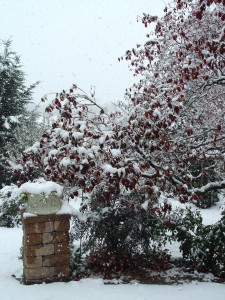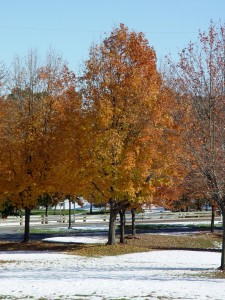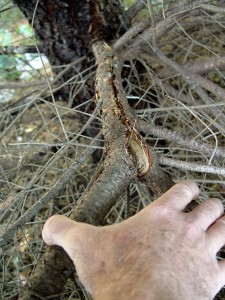One More Weather Insult
October 30th, 2011
Another week, another weather calamity. This time it was a record-setting October snow – one that tore the branches off trees and shrubs that hadn’t even lost their leaves yet.
Most of the damage I saw was to the fastest-growing, weakest-limbed species, especially flowering pears, willows, silver maples, elms and poplars.
But that snow was so heavy and created so much weight by sticking to leaves that even some moderately strong maples and oaks split.
The good news is that within a day, the snow was mostly off the branches. The warm ground, the sunny sky and the forecasted return to 50-degree days should get rid of this premature 5 or 6 inches pretty fast.
Take heart. We should have a few decent outside days left to yank the annuals, clip frost-killed perennials and take care of other fall cleanup jobs before winter shows up for real.
Once again, I’m impressed with just how resilient most of our woody landscape plants are.
Dogwoods, birch and oaks that were sagging practically to the ground on Saturday were back to looking normal by Sunday. Except that it was weird seeing trees in their fall clothes surrounded by white ground.
It looked like a duel between fall and winter.
Sometimes, the best thing you can do when snow or ice weights down branches is nothing.
That’s especially true if the sagger has come into contact with power lines. Wood isn’t the best conductor of electricity, but a branch touching a live power line may pack enough punch to make you wish you’d stayed inside.
Whacking branches with a broom or shovel may end up snapping branches and causing worse damage than if you had left nature take care of things.
If you’re worried that a branch is getting close to snapping, at least brush gently and only in an upward motion. Whacking downward adds to the pressure and is more likely to cause a snap.
Also stay on the ground. Climbing up a ladder with slippery footwear while waving around a long-handled implement is a recipe for an emergency-room visit.
If anyone’s limb is going to break, better it be the tree’s than yours.
So what about branches that did break?
Small to mid-sized branches that have partially split may be fixable.
Pull the split parts back together and either 1.) wrap tightly with burlap or soft cloth, or 2.) secure them with bolts.
If the repair is made before the inside wood calluses over, the broken branch has a good chance of growing back together. Get to this ASAP while the wood’s still wet. Wraps can be removed next summer. Bolts can stay in. New wood will grow around them.
Badly broken branches should be cut off cleanly – ideally back to live, uninjured growth or back nearly flush with the main trunk if it’s a large branch.
Try to cut at a joint (where two branches meet) or back to just outside the little ring where a large branch attaches to the trunk. Don’t let behind stubs that will only die and possibly rot, allowing harmful fungal growth to work its way back into the trunk. But also don’t cut so close that you’re gouging into the trunk wood itself.
Tar or similar tree paint isn’t needed. Just let the clean, sharp cut air-dry. The tree should heal nicely.
Again, attempt repairs and cuts only if you can reach them from the ground.
For higher-up “hangers,” large-scale splits and especially leaning or toppled big trees, it’s time to call a tree company.
Yeah, it’s expensive, but it’s safer, and it’s possible that your homeowners insurance will cover some of the cost.
Evergreens such as arborvitae and hemlocks that have splayed apart may look better once they have a few days to recover. Otherwise, use soft ties (old nylons are ideal) to create a straitjacket effect that pulls sprawling branches back tightly into place.
Breakage to shrubs will be easier to clean up and heal. Anything that’s broken or badly split, go ahead and prune it off now. No need to wait until spring. Especially for multi-stemmed shrubs such as lilacs, butterfly bushes and hydrangeas, they’ll bounce back very quickly and probably look close to normal next season already.
If you’re already thinking about replacement trees, here’s a link to a column I wrote on “muscle trees” — why some trees break sooner than others, 15 good choices that resist breakage and tips on minimizing storm damage.
Really, it’s a wonder that anything is even left standing after the assorted batterings we’ve endured this year.
We’ve had tornados, hurricane remnants, several floodings, an all-time wet year, a 100-degree heat spell, wind storms, hail storms, an earthquake and now a rare pre-Halloween dumping of snow.
About the only thing we haven’t seen yet is a volcano, and if we get one of those, I’m outta here.










